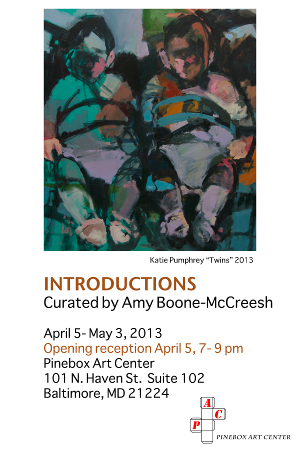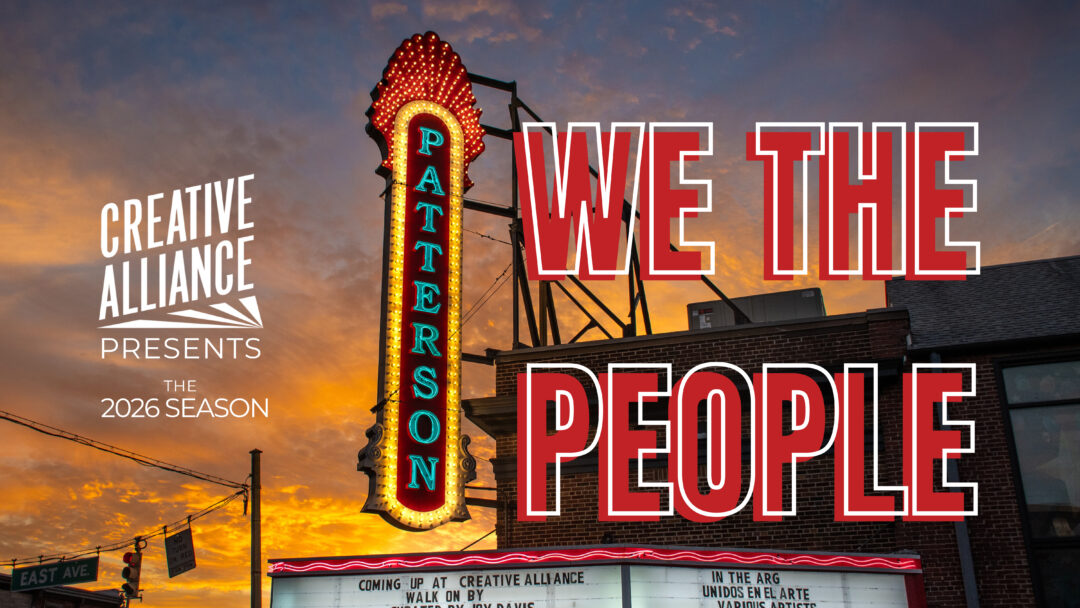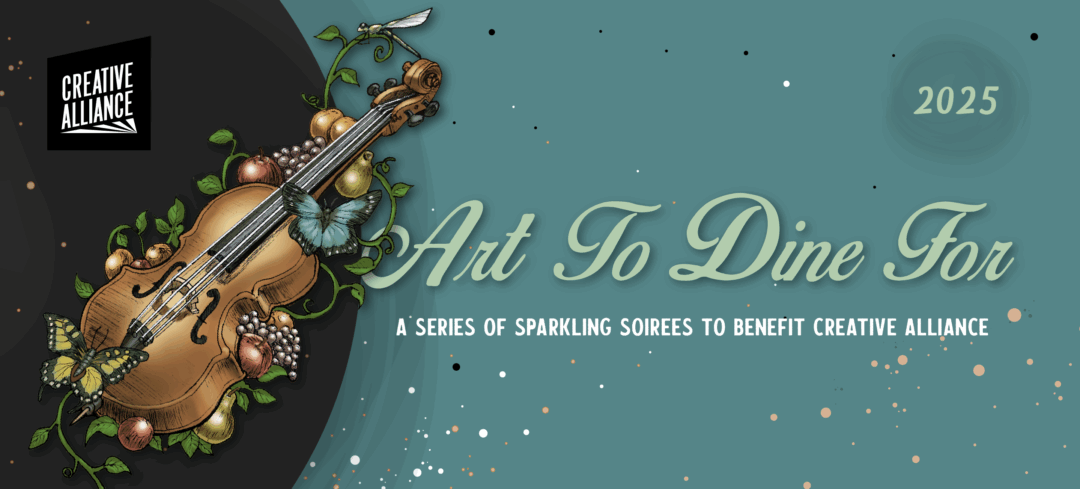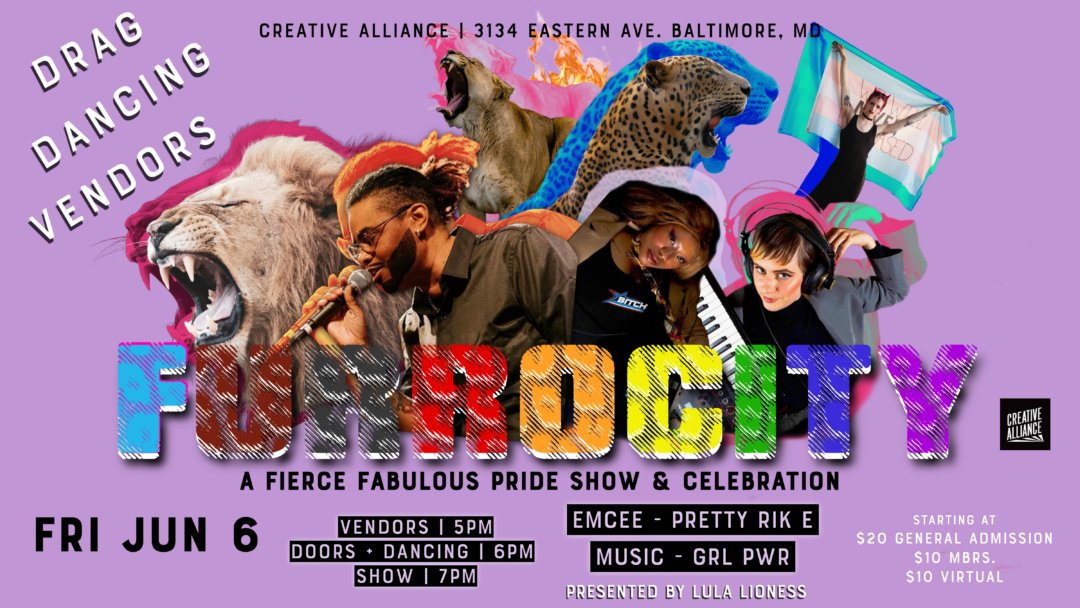
Curatorial Practice MFA candidate Chloe Gallagher interviewed Katie Pumphrey, Creative Alliance resident, about a new body of work, sports, and her stay at the Creative Alliance. You can see Katie’s work in the current exhibition Introductions at the Pinebox Art Center. Chloe Gallagher has curated the Globe Posters exhibition, opening at the Creative Alliance April 27, 2013.
Katie: I’m from Frederick, MD, also known as “Fredneck.” I went to MICA for undergrad, graduated in 2009 as a painting major. I’m currently a resident at the Creative Alliance, I’ve been there for a year and a half, have another year and a half to go.
Chloe: The Creative Alliance residency is three years?
Katie: It’s one to three years, you kind of decide as you go. I have until July of 2014, and part of that is a two-person show. I’ll be showing with Alessandra Torres, who’s also a resident, in January 2014. I’m a swim coach, competitive age groups, year round.
Chloe: So you were a swimmer yourself I take it?
Katie: Yes, yeah, so that influences my work a lot.
Chloe: I saw that you have a lot of athletic themes going on.
Katie: Yeah, and the choice to go to MICA was a big choice; to go to MICA or go to University and swim. Deciding to go to MICA I got into open water swimming a lot, and distance swimming. I’ve been doing some marathon swims, working towards others. It that kind of pushing my body that’s been a big part of my work. I think that’s a lot of why my work is large, I like that kind of physical challenge, I like to climb up on ladders and move around a lot.
Chloe: Do you think of your paintings as marathons themselves?
Katie: Sometimes, yeah I think so. A lot of my work has been about competition, and the instinct to be competitive, or like to fight the urge to stop. A lot of time my paintings can be like races, and I paint really fast.
Chloe: Do you paint fast as part of your process, intentionally, or have you just developed a habit of being a fast painter?
Katie: I think MICA creates fast painters. I think that’s kind of part of their thing, whether they realize it or not. A lot of painters I know from MICA are fast. But for me I like to push that, see how fast I can go. Then you’re really getting into your instincts, just your natural reactions: what the next move should be, whether you think that’s good or not, or if you should abandon it or change it. I’m still kind of figuring out how that fits into everything while creating this body of work that has to do with all of it.
Chloe: And the body of work we’re talking about is the work you’re creating for Pinebox, or for the two-person show at Creative Alliance?
Katie: It’s all along the same train of thought. The work for Pinebox is a lot more figurative, well I think all of my work is figurative. There’s been a bunch of work I’ve done recently with hunting dogs and packs of dogs, along with competitive nature, instinct, the group mentality or communication -more so communication. The dogs, for me, are a perfect way to explore that because there is no language, it’s just your body language. It’s partly the same reason I’ve been exploring rugby. For the show at Pinebox there’s a painting that’s rugby players.
Chloe: How are you liking the Creative Alliance residency?
Katie: It’s great, I love it. I was just talking yesterday to someone who was interested in applying. It’s important to know that living in an art center has its challenges. Just because you know there are always people there, sometimes if you want it to be quiet there’s an opening happening or an event, but that’s also something that makes it really great, in that it’s convenient and easy to be involved. Most everything’s really fun, and having a bar downstairs doesn’t hurt.
Chloe: As a resident of Highland town, which is a designated arts district are you happy to see new places moving in, like Pinebox? How did you first hear about them, and how did you get involved with Amy and the show there?
Katie: Yeah, I heard about Pinebox because I’d known Vincent, we had a short interaction. I was actually about to apply for a solo show there, I’d heard about it and seen the website, they were looking for submissions and right as I was working on it Amy emailed me. This is one of my first shows since graduating MICA outside of the Creative Alliance, so I’m pretty excited about that.
Chloe: My experience with Baltimore so far is that it’s a very collaborative and supportive art community. Do you feel similarly and do you get that sense of community at the Creative Alliance, in Highlandtown, and particularly working with new venues like Pinebox?
Katie: Yeah, in Baltimore I think everyone is really up for anything, that’s one of the great things. Everyone’s looking for new things, wanting new things. Even new bars that open everyone’s just like [makes swooshing noise] goes to that. With it being such a small town everyone’s always looking to be surprised. The Creative Alliance is always really great about whatever we want to do, you know “Go for it.” And that’s part of the reason I love my neighbors. I have coffee with my neighbor almost everyday, and talking about our work. It’s nice to be surprised, it’s nice to get feedback. And that’s really the reason I love the residency, the casual conversation about artwork that’s not as grand of a scale as school, not as intense as like a shorter residency. It’s your home, and the language and the communication becomes like that, like you’re just having coffee.
Chloe: You mentioned earlier that the work you’re creating for both your Pinebox show and your two-person show at Creative Alliance is an extension of the work you were making before. Are you trying to do anything new with these paintings, is there anything you were investigating that you weren’t investigating before?
Katie: For Pinebox, with the dogs, with a lot of my work I still think of it very figuratively, but making the conscious decision of a figurative show made me think more about the figure as something concrete, and kind of where I want to push that and where I want to let it be a little more loose. That’s been kind of interesting, but my work is all very new. It’s only really been the past year or so, exploring some of these ideas. I just spent the last month at Vermont studio center. It was wonderful, but part of the difference between the Creative Alliance residency and that kind of residency is that that was so intense. That’s all I was doing, you’re making new friends and you’re really just allowed to get submerged in everything, but also being there I felt like I needed to make big jumps in these new directions. So since then, and that was only in November so it really hasn’t been that long, I felt like I needed to fill in a lot of the blanks. I made these jumps with images of hunting and thinking about posturing and the idea of pride with competition, and more specific body language. What I’ve been thinking about with rugby players is similar to the dogs. They are able to talk, but in the scrum so much is happening all at once, and they’re listening to cues from people outside of the scrum. There’s so much happening that’s not just about their communication, but is about force and push. There’s a lot of that that I’m exploring, but I’m not really sure how to get at it. So a lot of it is just filling in those blanks.
Chloe: It’s good that you have these shows to build work for and really explore it.
Katie: Yeah, and there’s a lot of little chapters, little branches over the bigger idea.
Chloe: A lot of these themes you’re talking about, they call to mind so many artists in my mind. Who are some of the artists, locally and beyond that you look to, investigate, are inspired by?
Katie: I love that question, and hate that question.
Chloe: I’m sure! It’s so cookie cutter.
Katie: Sort of. I mean, I look to a lot of artists but recently I’ve been looking for only paint’s sake. I’ve been trying not to look, and actually have gone to a lot less openings. I think because of it I had a lot voices in my head. I think I’ve been getting rid of some of the voices from college, some of the professors at MICA; kind of feeling my own way. I think that was a big thing with Vermont, it taught me to figure it out and then maybe look around more. So right now I’m not really looking at anyone, and kind of being careful about that.
Chloe: Do you look to things beyond the art world? Do you watch rugby? Do you read about hunting?
Katie: I do a lot of research, and I want to do even more. Swimming is definitely a big push for me. Right now I’m training for a race in June. A lot of the work came from coaching, and that feeling of my two worlds –swimming, especially coaching, and artfeeling so separate. A lot of that was wondering why don’t I explore the things I’m thinking about in swimming? Like the idea of teaching a kid to be competitive, you can’t. You can encourage it, a good competition. Coaching has brought a lot of this stuff out. It’s very strange to see a talented swimmer not having that instinct to when they’re being passed to push harder, because a lot of people are just going to let it go, they just let it happen. It was a big jump for me when I decided to merge those two worlds, or use them to my advantage. I definitely look to my swimmers, that’s why some of my paintings have been about swimming. Or even looking at image, like I’ve gone to rugby games, I’ve gone to horseraces. Looking at those images, but then relating what I might be observing to how I feel when I race. Definitely a lot of research, and I want to do more. I’ve been talking to some club rugby teams in DC that I have some friends on, about getting in there a little bit. But I’m also trying to be careful about sports, because I’ve also been thinking about competitiveness amongst artists or in our everyday lives and that’s where body language can kind of branch off into its own thing too, just the way we handle each other. It has a lot to do with human interaction and behavior, but I’m not really sure how to explore all that just yet.
Chloe: Sounds like you’re figuring it out and you’re working hard.
April 2013




